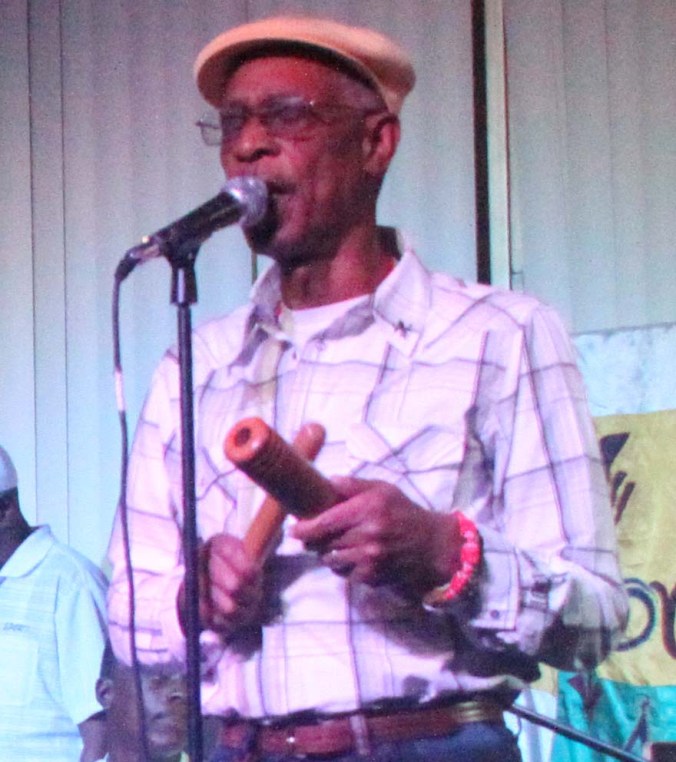Home / Culturales / De luto los tambores cubanos: Falleció Geovani del Pino, rumbero mayor
De luto los tambores cubanos: Falleció Geovani del Pino, rumbero mayor
Posted on 23 mayo, 2016 by Café Fuerte in Culturales, Destacadas, Música
El rumbero Geovani del Pino (1942-2016)
Por Fabián Flores
LA HABANA.- Cuba perdió este domingo a uno de sus rumberos mayores. Un genuino artista salido de las raíces mismas del barrio, la esquina y los muelles del puerto: Geovani del Pino Rodríguez.
Del Pino falleció la madrugada de este domingo en La Habana, a causa de un accidente cerebrovascular, según anunciaron los medios oficiales. Tenía 74 años y estaba en la plenitud de su carrera musical.
Cantante, percusionista, compositor y director del grupo Yoruba Andabo, Del Pino fue un gran cultor y promotor de la rumba, y acababa de ganar el Premio Cubadisco 2016 al Mejor Album de Música Tradicional Afrocubana con Soy de la tierra brava.
Rumba en el barrio
Nacido en La Habana, en la barriada de Centro Habana, en 1942, Del Pino creció oyendo rumba desde que tuvo uso de razón, en su casa de la calle Salud, entre Oquendo y Soledad. Pura rumba de cajón en el barrio y la esquina que marcó para siempre su vida.
En plena infancia, cuando tenía ocho años, un día los mayores que estaban tocando se levantaron y Del Pino se sentó en el tumbador y fue para siempre, porque nunca más dejó de tocar.
Estudió y laboró como soldador en la Flota Cubana de Pesca en el Puerto de La Habana, donde se incorporó a un grupo aficionado de los muelles que se reunía para tocar en fiestas familiares y eventos sindicales, desde los años 60. El grupo se nombraba Guaguancó Marítimo Portuario, que luego daría origen al mundialmente conocido Yoruba Andabo.
Para Del Pino, su historia como rumbero cambió en 1985, de la mano del trovador Pablo Milanés.
Por entonces había pedido la baja de la Brigada de Reparación de la Flota Cubana de Pesca y se sumó a un encuentro con miembros del Guaguancó Marítimo Portuario en la Peña del Ambia, que organizaba el poeta Eloy Machado en la sede de la Unión de Escritores y Artistas de Cuba (UNEAC). Fue allí donde los descubrió Pablo Milanés y los invitó a que lo acompañaran en un concierto suyo en el teatro Karl Marx.
Comienza la leyenda
Lo demás es historia. El grupo adoptó por nombre Yoruba Andabo y comenzó a tejer una discografía que suma ya una veintena de títulos, colaboraciones con figuras legendarias como Tata Güines, Merceditas Valdés, Celeste Mensdoza y Lázaro Ross, y múltiples presentaciones en escenarios internacionales. Uno de sus momentos de gloria fue la actuación a lleno completo en el Carnegie Hall de Nueva York, el 30 de noviembre del 2012. Los tickets se vendieron a $300 dólares para esta presentación, la primera de un grupo cubano de rumba en esa Meca cultural.
Yoruba Andabo lo alcanzó un premio Grammy Latino por La rumba soy yo, en el 2001. Otros dos de sus títulos fueron nominados al Grammy: Tremenda rumba, en el 2003, y Rumba en La Habana… con Yoruba, en el 2006.
La compañía la integran actualmente 16 artistas (cantantes, percusionistas y bailarines) y cultiva ritmos de raíz africana, fusionándolos con otros géneros musicales. Del Pino fue un gran creador y arreglista del repertorio de la agrupación.
Su labor promocional se extendió a los Festivales Internacionales Timbalaye, efectuados en Roma, así como a la impartición de conferencias y clases magistrales en universidades e instituciones culturales de Europa y Estados Unidos.
En paz y con mucha rumba descanse, Su Majerstad, Geovani del Pino.





































